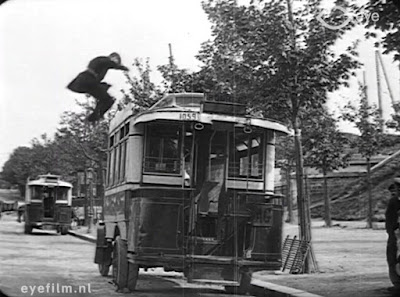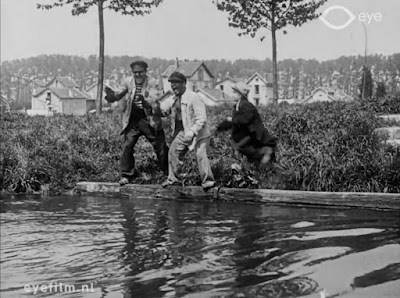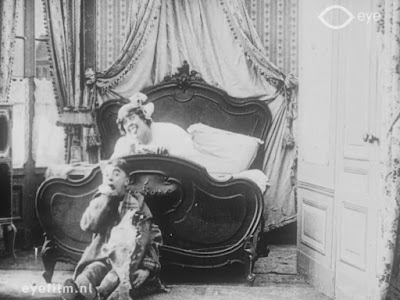The wonderful Eye Filmmuseum has posted many charming early comedies recently.
De Betooverde Schaatsen (1908, Lux)
A man creates chaos and destruction as he speeds through town on skates.
You can view the film at https://www.youtube.com/watch?v=pdf7iiTjIDE.
Vriend jaap haalt suiker (1911, Eclair)
A woman wreaks havoc while riding a bicycle.
Le nain detective (1909, Lux)
A dwarf detective, Little Bobby, thwarts a band of thieves.
You can view the film at https://www.youtube.com/watch?v=fv-4KsZymzM.
Julot a le sourire (1910, Eclipse)
A man cannot stop laughing over a joke he's heard.
You can view the film at https://www.youtube.com/watch?v=3s0mALFlY-o.
Teddy a mangé des grenouilles (1912, Lux)
Teddy (Édouard Pinto) soon finds after eating a tasty meal of frog legs that he, himself, can jump high like a frog.
You can view the film at https://www.youtube.com/watch?v=wBpTADs5OZw.
Een kleverige geschiedenis (1912, Lux)
After falling into wet tar, a man has the problem of everything sticking to him.
A baby sticks to him.
A dress shop dummy sticks to him.
Feathers stick to him.
His wife (a man dressed as a woman) gives a rough bath when he gets home.
You can view the film at https://www.youtube.com/watch?v=zcTz9zPYXJo.
Gratitude obsédante (1912, Lux)
Eye Filmmuseum
Flippie Brom is saved when he wants to commit suicide. He is given an umbrella and money. He is so grateful to the donor that he follows him - to the great annoyance of the donor. To get rid of Flippie, the donor even tries to drown him. Finally Flippie is run over and loses his lower legs. The donor runs away with the lower legs. But even crawling, Flippie finds him again.The film includes a funny gag in which a man becomes stuck to a moving wagon wheel.
Here's the scene in which Flippie loses his legs.
You can view the film at https://www.youtube.com/watch?v=JDSoNgUQFwA.
Gratitude obsédante is pre-dated by Faithful, a 1910 Biograph comedy that also derived humor from a pathologically grateful man. The Film Index reported:
John Dobbs [Arthur V. Johnson], a young man in good circumstances, goes a-courting, and returning from the home of his lady fair, his auto runs down Zeke [Mack Sennett], the vacuum-pated roustabout of the town. Although Zeke was not hurt, he was the recipient of a severe jolt which gave him a temporary case of nerves, which scared John into a fit of earnest solicitude. Imagining the tattered condition of Zeke's clothing was due to the accident, he not only soothes his imaginary hurts with a balm of silver dollars, but takes him to the store and buys him a suit of "hand-me-downs." Zeke is quite unaccustomed to such a bestowal of munificence, and his gratitude is accordingly excessive. So much so that he then and there swears eternal friendship: that he will never desert him; that he will stick to John through thick and thin. John cries. "Holy smoke! What am I up against?" and jumping into his auto dashes off under the impression that he has left the poor simple-minded Zeke on the sidewalk. But not so; for when he alights at his home, Zeke is there beside him, having hooked behind the machine as it darted off.. . . [John] can't move without Zeke at his side, his face wreathed in a smile that is childlike and bland, exclaiming - "I can't be happy without you."John and his sweetheart are in a romantic tête-à-tête when Zeke comes between them to "earnestly plead his friend's cause." John is so angry that he clubs Zeke, but this in no way deters Zeke. The Film Index continued:
Flight seems the only course, and John beats it. He has covered miles and sinks down from sheer exhaustion. There he sits panting, but happy in the thought of at last evading his tormentor, only to glance up and see Zeke's beatific countenance gazing fondly down at him.Zeke's legs remain intact throughout the story.
La Journée de Fifi (1912, Eclipse)
Eye Filmmuseum: "Short comedy with the little boy Fifi who, when his parents go out, smashes his piggy bank and goes crazy. He gets drunk and brought home by the police."
You can view the film at https://www.youtube.com/watch?v=7QoADGIhkpw.
De avonturen van Fifi (1912, Eclipse)
A little boy, Fifi, has an eventful day.
A seltzer bottle attack erupts. This is more expansive than the seltzer bottle attack we just saw in Julot a le sourire.
Fifi's guitar-playing inspires a couple to stop fighting and, instead, dance to the music.
Fifi recovers a dog stolen from a blind beggar.
You can view the film at https://www.youtube.com/watch?v=RWRuBBTM_Rw.
Gavroche au Luna-Park (1912)
Gavroche (Paul Bertho) visits a popular fairgrounds in Paris. He stumbles up the funhouse staircase, which made me think of Charlie Chaplin stumbling up esclator steps in The Floorwalker (1916).
Later, he leads a band.
You can view the film at https://www.youtube.com/watch?v=BX9hEp0-igg.
Bertho got laughs with a series of lion comedies. Let's take a look at four of these films.
Gavroche peintre Celebre (1912)
A painter adopts a lion as a pet.
You can view the film at https://www.youtube.com/watch?v=TCIeiTE-YQA.
Gavroche rêve de grandes chasses (1912)
Gavroche dreams he is on a big hunt and gets chased up a tree by a lion. While fighting for his life against the lion, he wakes up to discover that he is choking his wife.
You can view the film at https://www.youtube.com/watch?v=OAOW6h8St0c.
Gavroche veut faire un riche mariage (1912)
A wealthy woman offers to marry the man who can give her the best fright. Gavroche, determined to win the woman as his bride, shows up at her estate with a lion.
You can view the film at https://www.youtube.com/watch?v=Ibptcvi_dj0.
Gavroche et Casimir s'entrainent (1913)
Gavroche gets the idea to adopt a lion so he can train the toothy beast to attack his annoying neighbor and romantic rival, Casimir (Lucien Bataille). By coincidence, Casimir steals a lion from the zoo with the intention of using the lion against Gavroche.
You can view the film at https://www.youtube.com/watch?v=c63wjVg2Bd8.
Italy's Museo Nazionale del Cinema (National Museum of Cinema) has a print of another early lion comedy, Polidor e i gatti (1913). Here is the plot summary provided by the museum:
When the householder decides to go on a journey, he recommends the house and his beloved cats to the waiter Polidor [Ferdinand Guillaume], but he cannot imagine the unexpected turns events will take in his absence: distracted, Polidor lets the cats flee, and so he decides to replace them with beautiful felines stolen from the circus.
You can view the film at https://vimeo.com/133023372.
During this period, Gaumont produced a more serious "lions on the loose" film, La maison des lions (1912). IMDb plot summary: "The lions escape from a private menagerie during a fashionable party."
The lion comedy has remained popular in films for more than a century.
Roaring Lions on the Midnight Express (1918)
When Summer Comes (1922)
Wild Game (1924)
Fast And Furious (1939)
Gavroche becomes an umbrella salesman.
You can view the film at https://www.youtube.com/watch?v=aJTgP5qjdcs.
Een lieverd (1911, Eclair)
A boy (actually an adult actor) creates mischief with his new toy gun.
You can view the film at https://www.youtube.com/watch?v=GaB690ODGRA.
De uitvinding van mijnheer Pimpelaar (1911, Eclair)
Pimpelaar can never stay on his feet when he gets drunk, so he has a carpenter to built him a device that can hold him upright throughout his merrymaking and allow his friends to wheel him home after closing time.
You can view the film at https://www.youtube.com/watch?v=797fuR8KsH8.
Willy roi des concierges (1912, Eclair)
Eye Filmmuseum:
Willy [William Sanders] is a boy who plays the house concierge, but he is very strict. He checks if everyone wipes their feet, drives away street musicians and makes sure that no carpets are beaten before eight o'clock in the morning. Willy also does not want dogs in the house and sends suppliers away. When the homeowner refuses to pay him for his services, Willy gets a fire hose and sprays everyone out of the house, including the owner. However, someone knows how to close the tap and Willy gets a beating.This film is a favorite of mine.
You can view the film at https://www.youtube.com/watch?v=CNMjeSzW730.
Willy et le vieux soupirant (1912, Eclair)
Willy is determined to get rid of his mother's suitor. He finally gets his way by arranging for the man to sit in a chair that he has smeared with glue.
You can view the film at https://www.youtube.com/watch?v=l1tZq4jC2BY.
Eye has recently posted several "Polycarpe" comedies. The foolish Polycarpe was played by Charles Servaès.
La permission de Polycarpe (1913, Eclipse)
Polycarpe, a soldier, is happy to be granted leave so that he can visit his girlfriend Mélanie. He fights with a man that he catches flirting with Mélanie and damages his uniform in the midst of the rough and tumble. His commanding officer reprimands him for returning to camp with his uniform in disarray.
La paresse de Polycarpe (1914, Eclipse)
Sleepy clockmaker Polycarpe is neglecting his job, which leaves it to his clocks to repair themselves. The self-repairing clocks are whimsically depicted through stop-motion animation.
You can view the film at https://www.youtube.com/watch?v=hLeb8o9fJ30.
Polycarpe commis d'architecte (1913, Eclipse)
IMDb reviewer Bob Lipton wrote:
Polycarpe designs a building and then goes along with the head of the firm and the builder to the site, where he destroys everything in a slapstick fashion.The film features early "high and dizzy" comedy.
It's still early days for Charles Servaes' character, so he is not the annoying idiot who is so pleased with himself that he has to tell the audience how funny it is to be annoying the film's other characters. Here he's just so clumsy that he inadvertently strews destruction about him, wherever he goes. In essence, the same, but he's not so pleased with the results.
You can view the film at https://www.youtube.com/watch?v=tHOcHm_P4e4.
La tenacite de Polycarpe (1914, Eclipse)
Polycarpe can't find a safe place to pose for his portrait.
L'omelette de Polycarpe (1913, Eclipse)
Polycarpe prepares to cook an omelette, but his stove won't heat because the chimney is blocked. Polycarpe's inept efforts to sweep the chimney causes soot to pour into his neighbor's kitchen.
La trouvaille de Polycarpe (1913, Eclipse)
Polycarpe finds an odd coin. He sets out to spend the coin, but no merchant recognizes it as legal tender. He ends up in altercations with a cab driver, a bootblack, and a waiter. Even a blind beggar refuses the coin. Polycarpe finally manages to use the coin to buy a newspaper, but he reads in the newspaper that the coin is a rare piece and the man who lost the coin is willing to pay a generous reward for it.































































































































































.jpg)






No comments:
Post a Comment